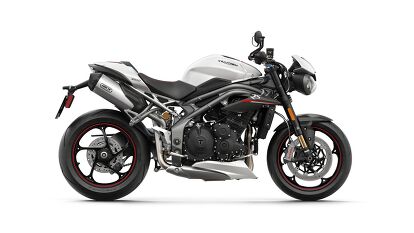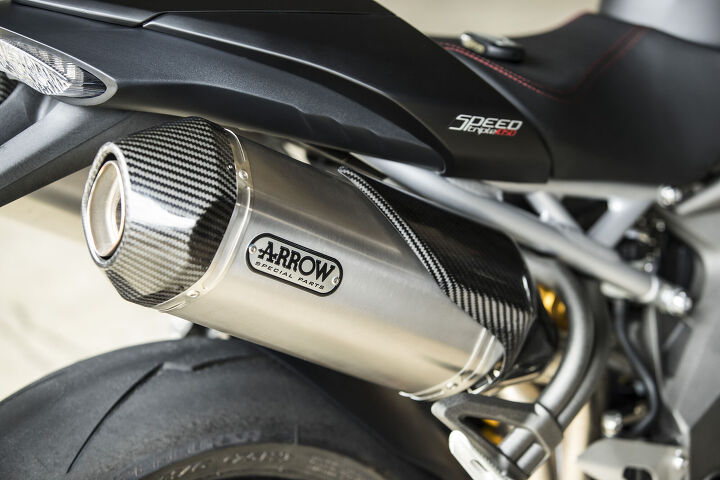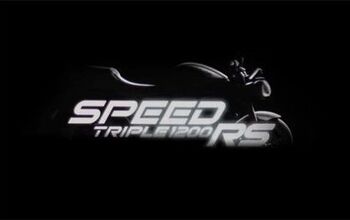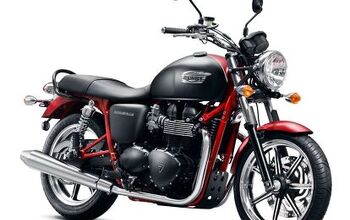Triumph Announces 2018 Speed Triple S And RS

In the last couple of weeks, MO has covered hints surrounding the 2018 Triumph Speed Triple S and RS no less than three times. While we were able to pull a few smidgens of information about the new models from CARB filings and teaser videos, the time is finally at hand. Triumph has officially released the specifications for the new Speed Triples – and they should make the bikes’ fans happy.
2018 Triumph Speed Triple RS Confirmed In CARB Filings
New Triumph Speed Triple Teased For Jan. 29
Fogarty VS Johnson On The New Triumph Speed Triple RS
First, the engine has been revamped. While the displacement remains at 1050 cc, this “major redevelopment” of the Triple accounts for no less than 105 new engine parts. With an emphasis on increased performance and lighter weight, the engine received a new, lighter crank gear. The Nikasil-plated aluminum cylinder liners are also lighter and contain new profile pistons that squeeze the fuel charge into higher compression ratio combustion chambers. The head itself has seen its exhaust ports optimized for improved gas flow. Additionally, a new freer-flowing exhaust, larger catalyst and lighter header system also aim to improve gas flow and thus bump performance in both the S and RS models. Finally – and significantly – the engine’s rev-limit has been increased by 1,000 rpm, yes!
According to Triumph, horsepower increased 7% to 148 hp (at the crank). Torque increased by 4% to a claimed 86 lb-ft. (Based on our previous dyno testing of the Speed Triple, we expect these numbers to translate to roughly 132 hp and 79 lb-ft at the rear wheel.)
Outside of the combustion chambers, other changes are aimed at increasing efficiency and redistributing weight. For example, a new sump places the oil lower in the engine for a lower CG while also reducing the lubricant’s parasitic drag by moving it further away from the spinning parts. The oil-flow through the cylinder head has been rerouted, which enabled the removal of external oil pipes for a cleaner look and reduced mass.
The transmission has been improved as has the slip-assist clutch for easier operation and to help avoid chatter during high-rpm downshifts. On the other end of the crankshaft from the clutch, a lighter alternator has taken up residence as one of the weight-saving features. More grams were shaved through the use of a smaller starter motor and lighter battery.
Electronics were also massaged for 2018. While the Ride Modes aren’t new, the angle adjustable full-color 5-inch TFT screen you set them on is. Naturally, each ride mode receives its own on-screen information layout. Controlling all this informational technology is all-new switchgear which is LED backlit for ease-of-use in both daylight and darkness. The RS also gains keyless ignition and a special lock/unlock button on the switchgear, enabling the rider to keep the electronic “fob” in their pocket at all times. In a move that’s sure to tickle and delight our inner John Burns, both models receive standard cruise control for 2018.
However, the real electronic wizardry takes place on the RS model. Thanks to an inertial measurement unit (IMU) that was developed in conjunction with Continental, cornering ABS and traction control make their way to the Street Triple. By tracking the constant changes of roll, pitch, yaw, lean angle and acceleration rates, the system can deliver the appropriate safety response when necessary. Also, as standard fitment on the RS in the US market only, Triumph Shift Assist allows for clutch-free up- and down-shifts “while maintaining the accelerator position.” Color us excited!
When it comes time to apply some whoa to the Pirelli Diablo Supercorsa tires both Speed Triples utilize 320mm rotors and Brembo four-piston two-pad M4.34 radial Monobloc calipers. The RS also sports matching Brembo adjustable brake and clutch levers. The RS’ premium trim also gains a carbon fiber front fender and radiator cowls. A color-matched belly pan and passenger seat cover are also standard on the RS, as is the matte aluminum subframe.
Suspension-wise, the Speed Triple S utilizes a fully-adjustable 43mm Showa upside-down fork and a monoshock rear suspension also by Showa. Fans of the Speed Triple RS probably already have a good idea what keeps its tires in contact with the road: a 43mm Öhlins NIX30 upside-down fork and an Öhlins TTX36 twin tube rear shock – both fully adjustable.
According to Triumph, all of these details combine to make the new 2018 S and RS the lightest, most powerful, and best handling Speed Triples to ever wear the name. The rest of us mere mortals will have to wait until they are available. Prices have not been set as of press time, but the color options have. The Speed Triple S will be either Jet Black or Crystal White, both with a titanium rear subframe, graphite wheel pinstripes, silver seat stitching and graphite decals. The Speed Triple RS will sport Crystal White or Matte Jet Black, both with a matte aluminum rear subframe, red wheel pinstripes, red seat stitching, and more premium RS decals.
Specifications | 2018 Triumph Speed Triple S | 2018 Triumph Speed Triple RS |
|---|---|---|
| Engine Type | Liquid-cooled, 12 valve, DOHC, in-line 3-cylinder | Liquid-cooled, 12 valve, DOHC, in-line 3-cylinder |
| Capacity | 1050 cc | 1050 cc |
| Bore/Stroke | 79 x 71.4 mm | 79 x 71.4 mm |
| Compression Ratio | 12.92:1 | 12.92:1 |
| Maximum Power | 148 HP @ 10,500 rpm | 148HP @ 10,500 rpm |
| Maximum Torque | 86 ft-lb @ 7,150 rpm | 86 ft-lb @ 7,150 rpm |
| Fuel system | Multipoint sequential electronic fuel injection with SAI | Multipoint sequential electronic fuel injection with SAI |
| Exhaust | Stainless steel 3 into 1 into 2, twin high level stainless steel silencers | Stainless steel 3 into 1 into 2, twin high level stainless steel silencers |
| Final drive | X ring chain | X ring chain |
| Clutch | Wet, multi-plate slip assist cltuch | Wet, multi-plate slip assist cltuch |
| Gearbox | 6-speed | 6-speed |
| Frame | Aluminum twin-spar | Aluminum twin-spar |
| Swingarm | Single-sided, aluminum alloy with eccentric chain adjuster | Single-sided, aluminum alloy with eccentric chain adjuster |
| Front Wheel | Cast aluminum alloy multi-spoke 17 x 3.5 in | Cast aluminum alloy multi-spoke 17 x 3.5 in |
| Rear Wheel | Cast aluminum alloy multi-spoke 17 x 6.0 in | Cast aluminum alloy multi-spoke 17 x 6.0 in |
| Front Tire | 120/70 ZR17 | 120/70 ZR17 |
| Rear Tire | 190/55 ZR17 | 190/55 ZR17 |
| Front Suspension | Showa 43 mm upside-down forks with adjustable preload, rebound and compression damping. 4.7 in (120 mm) travel | Öhlins 43 mm NIX30 upside-down forks with adjustable preload, rebound and compression damping. 4.7 in (120 mm) travel |
| Rear Suspension | Showa Monoshock with preload, rebound and compression damping, 5.1 in (130 mm) rear wheel travel | Öhlins TTX36 twin tube Monoshock with preload, rebound and compression damping, 5.1 (130 mm) rear wheel travel |
| Front Brake | Twin 320 mm floating discs, Brembo 4-piston 2-pad radial monobloc calipers. Switchable ABS. | Twin 320 mm floating discs, Brembo 4-piston, 2-pad monobloc radial calipers. Switchable ABS |
| Rear Brake | Single 255 mm disc, Nissin single 2-piston sliding caliper. Switchable ABS. | Single 255 mm disc, Nissin single 2-piston sliding caliper. Switchable ABS |
| Length | 81.7 in (2,075 mm) | 81.7 in (2,075 mm) |
| Width (Handlebars) | 30.5 in (775 mm) | 30.5 in (775 mm) |
| Height Without Mirrors | 42.1 in (1,070 mm) | 42.1 in (1,070 mm) |
| Seat Height | 32.4 in (825 mm) | 32.4 in (825 mm) |
| Wheelbase | 56.8 in (1,445 mm) | 56.8 in (1,445 mm) |
| Rake | 22.9 º | 22.9 º |
| Trail | 3.6 in (91.3 mm) | 3.6 in (91.3 mm) |
| Dry Weight | 423 lb (192 Kg) | 423 lb (189 Kg) |
| Fuel Tank Capacity | 4.1 US Gal (15.5 L) | 4.1 US Gal (15.5 L) |
| Fuel Consumption | 45.3 US MPG (5.2 l/100km) | 45.3 US MPG (5.2 l/100km) |
| CO2 Emissions | 119.0 g/km | 119.0 g/km |

Like most of the best happenings in his life, Evans stumbled into his motojournalism career. While on his way to a planned life in academia, he applied for a job at a motorcycle magazine, thinking he’d get the opportunity to write some freelance articles. Instead, he was offered a full-time job in which he discovered he could actually get paid to ride other people’s motorcycles – and he’s never looked back. Over the 25 years he’s been in the motorcycle industry, Evans has written two books, 101 Sportbike Performance Projects and How to Modify Your Metric Cruiser, and has ridden just about every production motorcycle manufactured. Evans has a deep love of motorcycles and believes they are a force for good in the world.
More by Evans Brasfield








































































































































































































































Comments
Join the conversation
http://stores.ebay.co.uk/ap...
Customized Products Aluminum Radiator
au_performance@live.com
Custom Aluminum Radiator For Bmw Triumph Aprilia Can Am Piaggio Agusta Ktm